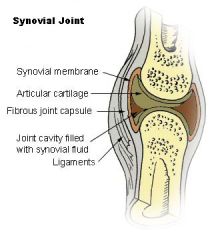![]()
![]()
![]()
Use LEFT and RIGHT arrow keys to navigate between flashcards;
Use UP and DOWN arrow keys to flip the card;
H to show hint;
A reads text to speech;
18 Cards in this Set
- Front
- Back
|
What are the two joint classifications? Name the three types of each
|
Functional
-Synarthrotic Joints: Immovable joints -Amphiarthrotic Joints: Slightly movable joints -Diarthrotic Joints - freely movable joints Structural -Fibrous Joints -Cartilaginous Joints -Synovial Joints |
|
|
Describe a fibrous joint
What are the three types? What type(s) of joint make up each category? |
Bones joined by dense CT; joint cavity is absent
-Sutures - In skull; baby skull (amphiarthrotic), adult skull (synarthrotic) -Gomphoses - b/t teeth and bony alveolar sockets; synarthrotic joints (amphiarthrotic caused by disease - tooth loss) -Syndesmoses - bones connected by ligaments (synarthrotic) or by interosseous membranes (amphiarthrotic) |
|
|
Describe a cartilaginous joint
What are the two types? What type(s) of joint make up each category? |
Cartilage connects bones; joint cavity absent
-Synchondroses - Hyaline cartilage connects bones (synarthrotic joint) - gives flexibility -Symphyses - Fibrocartilage connects bones (amphiarthrotic joint) - gives flexibility & strength |
|
|
Describe a synovial joint
What are two types? What type(s) of joint make up each category? |
Ligaments bind the bones; joint cavity present; dense regular CT
ALL synovial joints are diarthrotic joints -pivot joints -hinge joints -ball-and-socket -saddle joints |
|
|
1) What is an example of a synchondroses?
2) What is an example of a symphyses? |
1) Epiphyseal plates
2) Intervertebral discs, pubic symphysis |
|
|
What are menisci and what are their function?
|
Disc of fibrocartilage extending from the articular capsule in the synovial cavity to improve the fit of a synovial joint, which minimizes wear and tear
|
|
|
What are bursae and what are their function?
|
Flat fibrous sacs containing synovial fluid to reduce friction where bones, tendons, ligaments, and muscles rub together
|
|
|
What are tendon sheaths and what are their function?
|
Elongated bursae that wrap completely around tendons subjected to a lot of friction; they reduce friction
|
|
|
What are 3 ligaments that reinforce synovial joints?
|
1) Capsular or Intrinsic Ligaments - located inside the fibrous capsule
2) Extracapsular ligaments - located external to articular capsule 3) Intracapsular ligaments - lcoated deep to the articular capsule |
|
|
What makes up a synovial joint?
|

Articular cartilage (caps bone ends), joint cavity (space w/synovial fluid that lubricates to reduce friction), articular capsule (double-layered - outer fibrous capsule, inner synovial membrane)
|
|
|
1) What tissue makes up the outer fibrous capsule of the synovial joint?
2) Is it vascular or avascular? 3) Is the articular cartilage that the synovial joint is enclosed by vascular or avascular? |
1) Dense irregular CT
2) Highly vascularized 3) Avascular |
|
|
Describe the makeup and function of the synovial fluid
|
The fluid provides nutrients and O2 to the articular cartilage and acts as a lubricant to reduce friction as the bones move at the joint. Contains hypotonic filtrate of blood
|
|
|
1) What is the difference b/t circumduction and rotation of a synovial joint?
4) Name 4 ways that synovial joints can move |
1) Rotation is moving a bone around an axis while circumduction is moving it in a cone shape
2) Glidding, abduction, adduction, circumduction, rotation, flexion, extension |
|
|
Types of synovial joints
1) Plane: -surface of bone 1 = -surface of bone 2 = -Mvmnt allowed = 2) Hinge: -surface of bone 1 = -surface of bone 2 = -Mvmnt allowed = 3) Pivot -surface of bone 1 = -surface of bone 2 = -Mvmnt allowed = |
1) Flat/Flat - gliding
2) Cylinder/Depression - back & forth mvmt (flexion/extension) 3) Rounded protrusion/Ring or sleeve composed of bone or cartilage - Rotation |
|
|
1) What joint allows us to move the head in a "NO" motion?
2) What joint allows us to move the head in a "YES" motion? |
1) Atlanto-axial joint
2) Atlanto-occipital joint |
|
|
Types of synovial joints:
1) Condyloid -surface of bone 1 = -surface of bone 2 = -Mvmnt allowed = 2) Saddle -surface of bone 1 = -surface of bone 2 = -Mvmnt allowed = 3) Ball-and-socket -surface of bone 1 = -surface of bone 2 = -Mvmnt allowed = |
1) Oval protrusion/oval depression - flexion/extension, abduction, adduction, circumduction
2) Convex-Concave/Concave-Convex - lexion, extension, abduction, adduction, circumduction 3) Spherical head/cuplike socket - ALL mvmnts allowed |
|
|
What is the only example of a saddle joint in the body?
|
Carpometacarpal joint of the thumb
|
|
|
What is arthritis?
|
A disease characterized by inflammation of synovial membranes that cause stiff and painful joints
|

